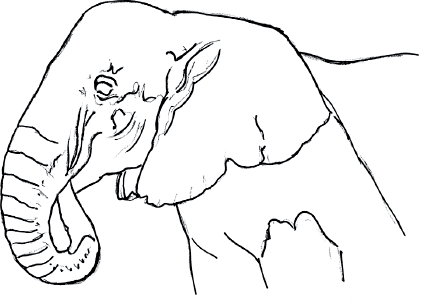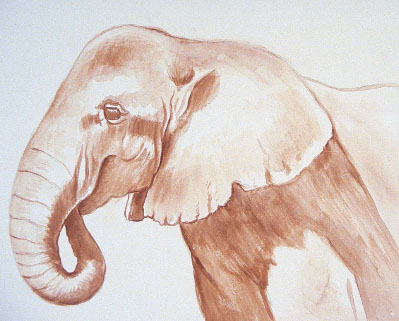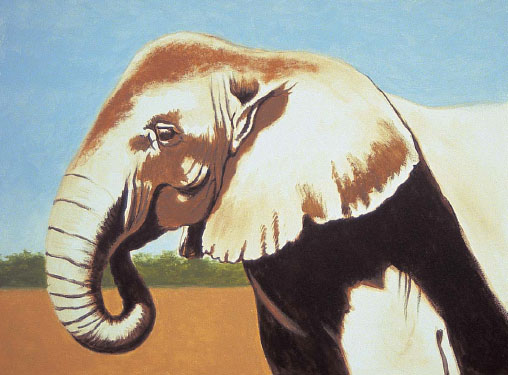Project 44: Elephant
I met Conga at the Black Beauty Ranch in Athens, Texas, a sanctuary for abused and abandoned animals created by the animal rescue group the Fund for Animals. Female African elephants (unlike female Indian elephants) have tusks, but Conga had lost her left one at some point. While we were visiting, Conga played a game of catch with us through the fence: we tossed a stick and Conga picked it up and tossed it back.


Reference Photo
Materials
Paints
Burnt Sienna
Burnt Umber
Cadmium Orange
Hooker’s Green Permanent
Naples Yellow
Raw Sienna
Titanium White
Ultramarine Blue
Brushes
no. 3 and 10 rounds
no. 8, 10 and 12 brights

1 Establish the Form
Lightly sketch the elephant onto the panel with a pencil, using a kneaded eraser to make corrections or lighten lines. With a no. 10 round and diluted Burnt Umber, paint the basic lines and shading. Use a no. 10 bright for the broad areas.

2 Paint the Dark Values
Create a dark brown with Burnt Umber, Burnt Sienna and Ultramarine Blue. Paint with a no. 10 round, switching to a no. 10 bright for broad areas. Use brushstrokes that follow the elephant’s contours.

3 Paint the Middle Values
Mix medium brown for the middle value shadows with Titanium White, Raw Sienna, Burnt Umber and a small amount of Ultramarine Blue. Paint with a no. 10 round, using a no. 8 bright for the broader areas. Mix a reddish color for the top of the head with a portion of medium brown mixed with Titanium White, Burnt Sienna and Cadmium Orange. Use dabbing strokes with a no. 8 bright.
Mix a green tree color for the distant tree line with Hooker’s Green Permanent, Cadmium Orange, Titanium White, Burnt Umber and Ultramarine Blue. Paint dabbing, horizontal strokes with a no. 10 round.
Mix a blue sky color with Titanium White, Ultramarine Blue and Naples Yellow. Paint dabbing strokes with a no. 12 bright. Mix light blue for the horizon with a portion of the blue sky color and Titanium White. Paint with a no. 10 bright, blending where it meets the blue sky color. Use a no. 3 round for the sky underneath the elephant’s chin. Use a no. 10 round and the green tree color to blend where the tops of the trees meet the sky.
Mix a wheaten color for the dry grass with Titanium White, Raw Sienna and Naples Yellow. Paint dabbing strokes with a no. 10 bright; switch to a no. 10 round for around the elephant’s outline. Use the green tree color to blend where it meets the wheaten.

4 Paint the Lighter Values and Begin to Add Detail
Mix a brownish gray for the elephant’s hide with Titanium White, Raw Sienna, Ultramarine Blue and Burnt Umber. Mix a lighter gray by adding more Titanium White to a portion of brownish gray. Paint the brownish gray areas with a no. 10 bright, using a no. 10 round for the smaller areas. Use the same size brushes to paint the lighter gray areas. Blend where the two colors meet, using a separate brush for each color.
With dark brown, blend where the shadowed areas meet the adjacent colors. Begin to paint the thin line detail in the elephant’s hide using a no. 10 round and the reddish color.
Tip
Although I saw the elephant in the U.S., I wanted it to appear as though she were in her native Africa. I referred to a book about elephants to see how trees in Africa differed from those in the reference photo. They were more angular, with horizontal rather than rounded clumps of foliage.

5 Add More Detail
Continue to paint detail on the elephant’s hide. For lighter tone lines, use less paint. Darken the middle value shadowed areas as needed with dark brown and a no. 10 round. Paint over these areas with very light parallel strokes.
Use the reddish color to paint pebbly detail in the lighter areas of the elephant. Use the dry-brush technique with a no. 10 round to paint small, dabbing strokes. For broader areas such as the ears, leg and back, use a no. 8 bright.
Tip
Animal eyes, especially elephant eyes, often do not show up well in photos. Take close-up photos of the animal’s eyes, or use a picture from your photo file or a book to see the detail.

CONGA
Acrylic on Gessobord
8” × 10” (20cm × 25cm)
6 Paint the Finishing Details
Mix a highlight color with Titanium White and a small amount of Naples Yellow. Paint highlights on the top of the head, ear and back. Paint highlights on the lower edge of the ear.
Mix a shadow detail color with a portion of medium brown and dark brown. Lightly paint detail in the dark shadowed areas with a no. 10 round. When dry, use a small amount of dark brown and a no. 3 round to lightly paint over and tone down the detail.
Mix the warm brown eye color with Burnt Sienna, Burnt Umber and small amounts of Cadmium Orange and Titanium White. Paint a small arc in the lower half of the eye with a no. 3 round, blending with a separate brush and dark brown.
Mix the blue-gray eyelash color with a bit of the blue sky color mixed with medium brown. Paint the eyelashes with a no. 3 round, blending with dark brown.
Mix a tree highlight color with a portion of the green tree color, Titanium White and Naples Yellow. Lightly paint detail with a no. 10 round, using quick, dabbing strokes.
Mix a dry grass shadow color with Titanium White, Burnt Umber and Raw Sienna. Use a small amount of paint on a no. 8 bright for the shadows, painting dabbing strokes.
